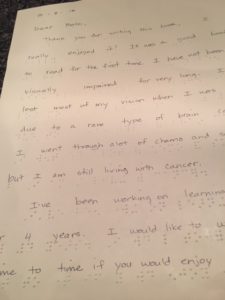Speech Software, Smartphones: Why Braille Still Matters
by Alicia
Louis Braille was born on January 4, 1809. His birthday is now annually recognized as World Braille Day, and January is Braille Literacy Awareness Month. I have long been aware of World Braille Day, but it’s only recently that I learned that the entire month is dedicated to Braille — how cool is that?!

A page written in Braille along with standard characters and words.
Though I don’t use Braille as often as I used to, it’s still a part of my life. I first learned Braille when I started preschool at age 3. My memories of this are foggy at best, but I do remember the first Braille book I read was called Go and Do. It introduced me to contractions, which are letters or symbols that are used to substitute for actual words. For example, the letter G by itself stands for the word “go.” Braille has a symbol for the word “and,” similar to how in print, you use the symbol “&” to mean “and.” The letter D by itself stands for the word “do.” This makes typing easier, as you do not need to type the entire word.
I read a lot of Braille in my school years. As far back as middle school, I remember textbooks being several volumes. Braille books are heavier, and the dots can take up so much space that the average print textbook is split up into several volumes when converted to Braille. This made for some accommodating in middle and high school — for my school presentations, I often needed to know ahead of time what pages we’d be working on so I could see if I needed to retrieve another volume of the textbook. If this concept confuses you, don’t worry; it confused my teachers when I’d try to explain it. They’d ask, “Doesn’t your textbook there just have all the pages like ours does?”…not in a patronizing way, but out of simple confusion.
Braille books can be very expensive, especially when they come in several volumes. So, you can imagine that this is why, when I’m reading books for pleasure at home, I prefer to listen to audio books. I read a lot of books (I love reading!) but after reading Braille for quite a while, my fingers can actually get tired. Sometimes, they hurt!
When I went to college, most of my assignments were done electronically. I could read textbooks using VoiceOver (the speech synthesizer on my iPhone), but I often took tests in Braille. I was given the option to either have them read tests to me in person or provide them to me in audio format. If I chose the audio format, someone from the Disability Resource Center would record the exam, I listen to the recording and write my answers in Braille. Later, my Braille answers would be transcribed into print for the professors to grade.
Audio format seemed like it took too much time, so I arranged to have my exams provided in Braille instead. The professors simply emailed the exam to the Disability Resource Center and they’d provide it in Braille. That way I wouldn’t have to rewind the audio or ask someone to re-read something if need be — I could simply use my fingertips to reread the question if I needed to.
To take notes in class, I’d use a Braille Note Apex (it essentially looks like a screen-less laptop). Similar to how words appear on the screen when you type on a laptop, the words would appear at the bottom on a Braille display. I could have used my laptop to take notes, but I would’ve had to use headphones so my classmates wouldn’t hear the screen-reading software on my computer. You can see the problem there: it’s hard to hear a class lecture with headphones on! Using just one earbud in my ear meant I might be too focused on the speech software and miss something the professor said. So I went with Braille.
As you might know from previous posts, I graduated from Northern Illinois University in December 2019. Most people think of Braille as a way to read books, but now that I’m done with school, I use it in ways you might not think of. We used my Braille writer — a very large typewriter of sorts — to label the cards so I can play card games with my family. I use Braille to read signs that verify bathroom signs or room numbers (though this was more applicable in college, but I’m sure it will be useful again post-pandemic, when I get out and travel more). Another example: I sometimes use sound clues to locate restrooms myself when alone at a coffee shop, and I check to see if there’s a Braille sign near the door to indicate it is the women’s restroom.
A common concern among parents is that after a blind person is through with their education, with everything being electronic these days, Braille skills will diminish, and a person may not read as well. But Braille is still there and still useful, from reading signs to playing games to even writing an old-fashioned card if you want to.
One of my (sighted) friends learned Braille and every year she writes my birthday card in Braille, and I’m grateful that she taught herself Braille and that I still use it outside of school.






